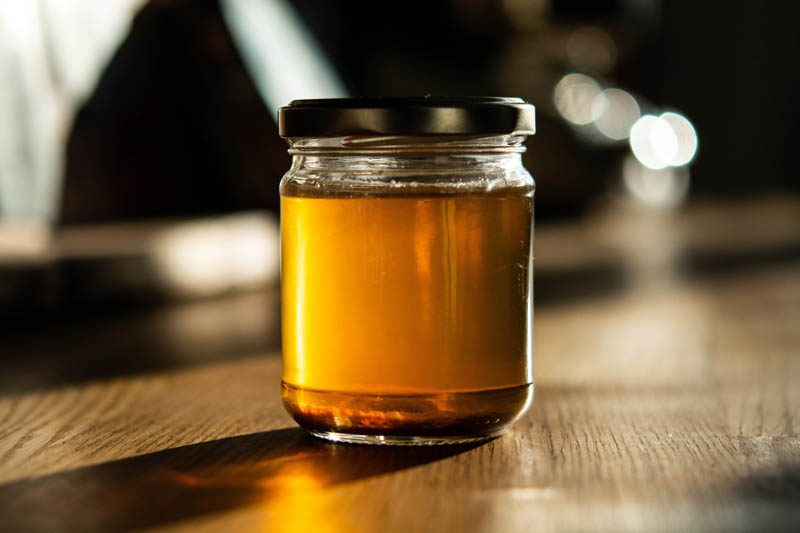What are grayanotoxins?
Grayanotoxins are a type of neurotoxin found in several plants of the Ericaceae family, including rhododendrons, azaleas, and pieris. Grayanotoxins bind to sodium channels on excitable cell (neurons, skeletal, cardiac and smooth muscles) membranes. This causes an influx of sodium ions and depolarisation of the cell leading to prolonged and repetitive action potentials and an overstimulation of the affected cells. These toxins can cause a range of symptoms when ingested, including gastrointestinal distress, dizziness, and even heart failure in severe cases. Grayanotoxins can also be found in honey made from the nectar of these plants, and consuming large amounts of such honey can lead to a condition known as “mad honey” poisoning. If you suspect that you or someone you know has ingested grayanotoxins, seek medical attention immediately.
Grayanotoxins bind to sodium channels on excitable cell (neurons, skeletal, cardiac and smooth muscles) membranes. This causes an influx of sodium ions and depolarisation of the cell leading to prolonged and repetitive action potentials and an overstimulation of the affected cells.
The action potential is an electrical signal that travels along the neuron that allows it to communicate with other neurons and muscles. At rest, the inside of a neuron has a negative charge and the outside has a positive charge which is maintained by channels in the cell membrane that allow certain ions such as potassium and sodium to move in and out of the cell. When a neuron receives a signal from another neuron or sensory receptor, channels in the cell membrane open, which allows positively charged ions like sodium to enter the cell causing it to become more positive, triggering the opening of additional channels, to allow even more positive ions to flow in.
The first recorded documentation of grayanotoxin poisoning was in 401 when Greek historian and soldier Xenophon documented the effects of mad honey poisoning on soldiers in his work “Anabasis,” describing how the honey caused disorientation, vomiting, and diarrhea.
Related: What are insoluble calcium oxalate crystals?
Sources of grayanotoxins
Grayanotoxins are found in plants belonging to the Ericaceae family, which includes Rhododendrons, Azaleas, and Mountain Laurels which are grown as ornamental plants in gardens around the world. All parts of the plants contain grayanotoxins including the nectar, pollen, flowers and leaves. Grayanotoxin is a secondary metabolite, which is an organic compound produced by plants not directly involved in the growth, development, or reproduction of the organism. Its purpose is to protect the plant against herbivores and pests.
Honey produced by bees that have fed on the nectar of grayanotoxin-containing plants is also a source of toxicity. Mad honey is a type of honey that contains high levels of grayanotoxin, which occurs after bees feed off the nectar of grayanotoxin-producing plants. Many cultures throughout history have used made honey for medicinal purposes to treat a number of medical conditions.
- Traditional medicine: In some cultures, mad honey has been used for centuries to treat a variety of ailments, including gastrointestinal disorders, hypertension, inflammation, and respiratory infections.
- Pain relief: Mad honey has been used as a natural painkiller in traditional medicine. It is believed that the grayanotoxins in the honey can act as a natural anesthetic.
- Wound healing: Mad honey has been used topically to treat wounds. One study found the application of mad honey to diabetic rats enhanced wound healing. This finding potentially has important ramifications for diabetics, as wounds heal slower in diabetics compared to non-diabetics.
- Anti-inflammatory effects: Some studies suggest that the grayanotoxins in mad honey may have anti-inflammatory effects, which could potentially be useful in treating conditions such as arthritis.
Mad honey

Consumption of mad honey can lead to ‘mad honey poisoning‘, which is the most common source of grayanotoxin poisoning in humans. Symptoms can range from mild to severe and include dizziness, weakness, vomiting, nausea, sweating and abdominal pain. Severe cases can lead to hypotension (low blood pressure) and cardiac arrhythmia (irregular heartbeat), seizures and potentially death from cardiac or respiratory failure. Pets (especially puppies and kittens), livestock and children are at increased risk of consuming toxic plants.
In Turkey and Nepal, mad honey is intentionally produced to use in traditional medicine as well as for its hallucinogenic effects. The Turkish referer to it as deli bal, which loosely translates to ‘crazy honey’ in English. Mad honey has been used as a traditional medicine by the Napalese to treat hypertension (high blood pressure), gastrointestinal disorders, and as an aphrodisiac.
Mad honey is legal in the United Kingdom and the United States but is illegal in South Korea, India, Mexico, Brazil, Canada and Australia.
Mechanism of action
Grayanotoxins can cause excessive and prolonged activation of voltage-gated sodium channels in cell membranes. This causes exaggerated depolarisation of the membrane potential. This can cause a number of physiological effects, such as altered nerve impulse transmission, muscle weakness, and cardiac arrhythmias. The toxic effects can vary depending on the type and concentration, the different tissues and the location and expression of the sodium channels. In the nervous system, grayanotoxin can lead to altered transmission of nerve impulses, leading to tingling, numbness and muscle weakness. Alterations to the heart rate and rhythm can occur in the cardiovascular system, which can be life-threatening.
Clinical signs of grayanotoxin poisoning
Symptoms develop within a few hours of ingestion and last up to 24 hours.
- Tingling or burning sensation in the mouth and throat, which can lead to difficulty speaking or swallowing
- Nausea
- Vomiting
- Abdominal pain
- Dizziness
- Sweating
- Blurred vision
- Weakness or paralysis
- Hypotension
- Cardiac arrhythmia
- Hallucinations
- Aspiration pneumonia due to inhaling vomit
- Loss of consciousness
- Death
Symptoms and their severity can vary depending on the dose and type of grayanotoxin. The dose-dependent effects of grayanotoxin are due to the toxin’s ability to interact with voltage-gated sodium channels in the body. At low concentrations, grayanotoxins may only bind to a few of these channels, leading to mild symptoms. However, as the dose increases, more channels are affected, leading to a greater depolarization of the cell membrane and a more severe response.
- Dose: The toxicity of grayanotoxins is dose-dependent, meaning that higher doses can cause more severe symptoms. Even small amounts of grayanotoxins can be toxic if ingested over a long period of time.
- Source: Different plants contain different types and levels of grayanotoxin. GTX-I, GTX-II, and GTX-III. GTX-I and GTX-III are the most potent.
- Route of exposure: The route of exposure influences the toxic effects. For example, oral ingestion of grayanotoxin is more toxic than dermal (skin) contact, due to the protective nature of the skin which acts as a barrier.
- Other factors: The season when the honey or plant was consumed, (spring honey has higher concentrations compared to other seasons), and the presence of other chemicals or toxins in the plant.
Diagnosis
A diagnosis of grayanotoxin toxicity in humans is based on a history of recent honey ingestion. Animals are more likely exposed via ingestion of plant matter, which can be difficult for a veterinarian to diagnose unless ingestion was witnessed. There is no test available to detect grayanotoxin in the blood.
- Medical history: The physical will obtain a medical history that can help identify if the patient has had exposure to honey or plants containing grayanotoxin. No prior history of heart abnormalities, low blood pressure, nausea and neurological signs may increase the doctor’s index of suspicion.
- Physical examination: A physical examination may reveal an abnormal heart rate, irregular heart rhythm, low blood pressure and neurological signs.
- Electrocardiogram (ECG): A recording of the electrical activity of the heart. The ECG may reveal an irregular heart rhythm or a decreased heart rate.
Treatment
There is no specific antidote to grayanotoxin exposure. Treatment is aimed at preventing further absorption as well as supportive care. This may include:
- Gastric decontamination: If ingestion was recent, the doctor or veterinarian will administer medication to induce vomiting, or perform gastric lavage (stomach pumping) to evacuate the stomach contents. This will be followed by activated charcoal to bind to any plant matter left behind.
- Fluid therapy: Intravenous fluids to help flush any remaining toxins out of the body, and maintain hydration and electrolyte imbalances.
- Saline infusion: A saline infusion increases blood volume which can help patients with mild hypotension and dizziness.
- Atropine: An anticholinergic drug that blocks the action of acetylcholine, a chemical messenger responsible for muscular movement, heart rate and glandular secretion. In patients with bradycardia, atropine can increase the heart rate.
- Gastroprotectants: Medications to protect the gastrointestinal tract from damage and irritation due to prolonged vomiting. These either reduce the production of gastric acid or form a protective barrier over the stomach lining.
During treatment, the doctor or veterinarian will conduct electrocardiographic monitoring.
Prognosis
The prognosis for grayanotoxin ingestion depends on several factors such as the amount of toxin ingested, overall health and how fast medical treatment was initiated. For human ingestion of mad honey, most cases will resolve in 24-48 hours with supportive care.
However, in rare cases, particularly when large amounts of the toxin are ingested or when medical treatment is delayed, the prognosis can be more severe, which highlights the importance of prompt medical treatment.
Prevention
Avoid consuming honey from unknown sources. Commercial honey is typically obtained from bees who have fed on the nectar of a variety of plants, versus mad honey from bees who have sourced nectar from grayanotoxin-producing plants such as Rhododendron species.
Most adults are unlikely to ingest grayanotoxin-containing plants. Children and pets are at increased risk due to their curious nature. Puppies in particular will chew on anything and don’t know the difference between a toxic and non-toxic plant. It is important to know which plants are safe to grow in the garden and which are toxic. If you do grow toxic plants, always supervise children and animals, or create barriers around the plants to prevent accidental ingestion.
Conclusion
|
Julia is a writer and landscape consultant from Wollongong with a love of horticulture. She had been an avid gardener for over 30 years, collects rare variegated plants and is a home orchardist. Julia is passionate about learning and sharing her knowledge of plant propagation and plant toxicology. Whether it’s giving advice on landscape projects or sharing tips on growing, Julia enjoys helping people make their gardens flourish.




